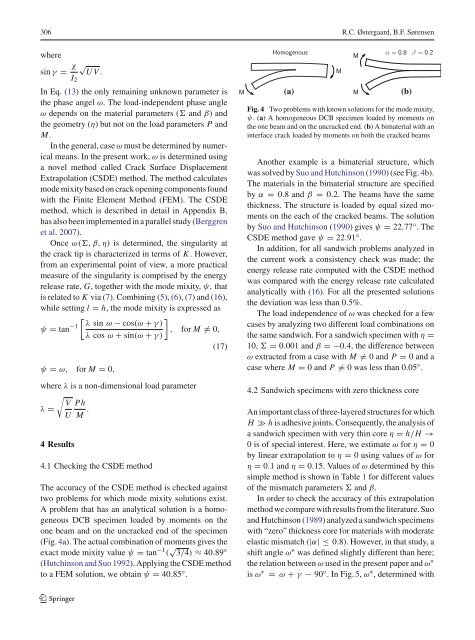Rasmus ÿstergaard forside 100%.indd - Solid Mechanics
Rasmus ÿstergaard forside 100%.indd - Solid Mechanics
Rasmus ÿstergaard forside 100%.indd - Solid Mechanics
Create successful ePaper yourself
Turn your PDF publications into a flip-book with our unique Google optimized e-Paper software.
306 R.C. Østergaard, B.F. Sørensen<br />
where<br />
sin γ = χ √<br />
UV.<br />
I2<br />
In Eq. (13) the only remaining unknown parameter is<br />
the phase angel ω. The load-independent phase angle<br />
ω depends on the material parameters ( and β) and<br />
the geometry (η) but not on the load parameters P and<br />
M.<br />
In the general, case ω must be determined by numerical<br />
means. In the present work, ω is determined using<br />
a novel method called Crack Surface Displacement<br />
Extrapolation (CSDE) method. The method calculates<br />
mode mixity based on crack opening components found<br />
with the Finite Element Method (FEM). The CSDE<br />
method, which is described in detail in Appendix B,<br />
has also been implemented in a parallel study (Berggren<br />
et al. 2007).<br />
Once ω(,β,η) is determined, the singularity at<br />
the crack tip is characterized in terms of K . However,<br />
from an experimental point of view, a more practical<br />
measure of the singularity is comprised by the energy<br />
release rate, G, together with the mode mixity, ψ, that<br />
is related to K via (7). Combining (5), (6), (7) and (16),<br />
while setting l = h, the mode mixity is expressed as<br />
ψ = tan −1<br />
ψ = ω, for M = 0,<br />
<br />
λ sin ω − cos(ω + γ)<br />
, for M = 0,<br />
λ cos ω + sin(ω + γ)<br />
(17)<br />
where λ is a non-dimensional load parameter<br />
<br />
V Ph<br />
λ =<br />
U M .<br />
4 Results<br />
4.1 Checking the CSDE method<br />
The accuracy of the CSDE method is checked against<br />
two problems for which mode mixity solutions exist.<br />
A problem that has an analytical solution is a homogeneous<br />
DCB specimen loaded by moments on the<br />
one beam and on the uncracked end of the specimen<br />
(Fig. 4a). The actual combination of moments gives the<br />
exact mode mixity value ψ = tan −1 ( √ 3/4) ≈ 40.89 ◦<br />
(Hutchinson and Suo 1992). Applying the CSDE method<br />
to a FEM solution, we obtain ψ = 40.85 ◦ .<br />
123<br />
(a) (b)<br />
Fig. 4 Two problems with known solutions for the mode mixity,<br />
ψ. (a) A homogeneous DCB specimen loaded by moments on<br />
the one beam and on the uncracked end. (b) A bimaterial with an<br />
interface crack loaded by moments on both the cracked beams<br />
Another example is a bimaterial structure, which<br />
was solved by Suo and Hutchinson (1990)(seeFig.4b).<br />
The materials in the bimaterial structure are specified<br />
by α = 0.8 and β = 0.2. The beams have the same<br />
thickness. The structure is loaded by equal sized moments<br />
on the each of the cracked beams. The solution<br />
by Suo and Hutchinson (1990)givesψ = 22.77 ◦ .The<br />
CSDE method gave ψ = 22.91 ◦ .<br />
In addition, for all sandwich problems analyzed in<br />
the current work a consistency check was made; the<br />
energy release rate computed with the CSDE method<br />
was compared with the energy release rate calculated<br />
analytically with (16). For all the presented solutions<br />
the deviation was less than 0.5%.<br />
The load independence of ω was checked for a few<br />
cases by analyzing two different load combinations on<br />
the same sandwich. For a sandwich specimen with η =<br />
10, = 0.001 and β =−0.4, the difference between<br />
ω extracted from a case with M = 0 and P = 0 and a<br />
case where M = 0 and P = 0 was less than 0.05 ◦ .<br />
4.2 Sandwich specimens with zero thickness core<br />
An important class of three-layered structures for which<br />
H ≫ h is adhesive joints. Consequently, the analysis of<br />
a sandwich specimen with very thin core η = h/H →<br />
0 is of special interest. Here, we estimate ω for η = 0<br />
by linear extrapolation to η = 0 using values of ω for<br />
η = 0.1 and η = 0.15. Values of ω determined by this<br />
simple method is shown in Table 1 for different values<br />
of the mismatch parameters and β.<br />
In order to check the accuracy of this extrapolation<br />
method we compare with results from the literature. Suo<br />
and Hutchinson (1989) analyzed a sandwich specimens<br />
with “zero” thickness core for materials with moderate<br />
elastic mismatch (|α| ≤0.8). However, in that study, a<br />
shift angle ω ∗ was defined slightly different than here;<br />
the relation between ω used in the present paper and ω ∗<br />
is ω ∗ = ω + γ − 90 ◦ .InFig.5, ω ∗ , determined with
















